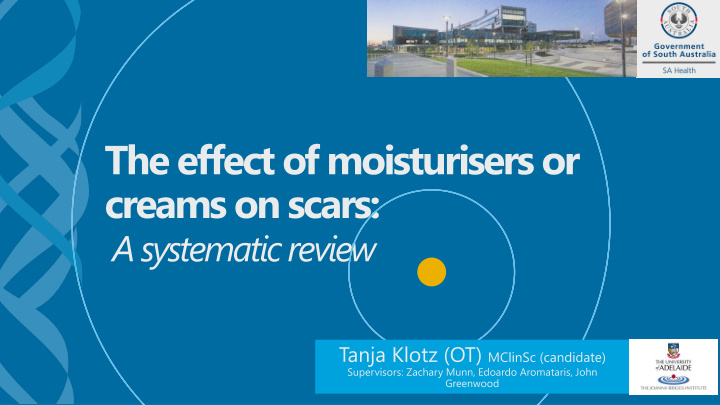



1
Background 2
METHODS Types of studies: all Animal studies The effect of massage Participants: people of any age, Atrophic scars Keloid vs hypertrophic vs linear scars from various causes and vs healed by secondary intention various types of scars Internal scarring or scarring of structures other than the skin Interventions: moisturisers of any type 3
SEARCH STRATEGY ? Database searches Pubmed • Embase • CINAHL • Web of Science • Grey literature https://clinicaltrials.gov/ • www.anzctr.org.au – Australian and New Zealand Clinical Trials Registry, online registry of • clinical trials being undertaken in Australia, New Zealand and elsewhere. www.controlled-trials.com - now called www.isrctn.com • www.opengrey.eu • http://www.cochranelibrary.com/about/central-landing-page.html •
Refining the search PRISMA Flow diagram outlining systematic review process Records identified through systematic search (N = 1970) Identification After removal of duplicates (N= 1419) Records excluded that did not meet Records screened (title pre-defined criteria (N=1281) and abstract) (N=1419) Screening Records identified via screening reference lists of eligible articles (N = 7) Full-text articles Full-text articles Full-text articles Eligibility retrieved and excluded following excluded (N = 39) assessed for critical appraisal eligibility (N = 73) (N = 1) Included 7 studies included in meta-analysis – Imiquimod post excision of keloids 26 studies included in narrative synthesis – Effect of moisturisers
6
Cosmesis 7
Scar parameters 8
Scar parameters 9
Itch & Pain 10
Outcomes measures 11
Other considerations 12
Final thoughts… Quality Quality of of Outcome Outcome Advers Adverse e Imiquimod Imiquimod stud studies ies meas me asures ures eve events nts 13
Summary of recommendations Cons Consider ider Avoi Avoid Use Use Stud Studies ies needed needed 14
“ References [1] Klotz T, Kurmis R, Munn Z, Heath K, Greenwood J. Moisturisers in scar management following burn: A survey report. Burns. 2017;43(5):965-72. [2] Klotz T, Kurmis R, Munn Z, Heath K, Greenwood J. The effectiveness of moisturizers for the management of burn scars following severe burn injury: A systematic review protocol. JBI Database of Systematic Reviews and Implementation Reports. 2014;12(11):212-20. [3]Murdock J, Sayed MS, Tavakoli M, Portaliou DM, Lee WW. Safety and efficacy of a growth factor and cytokine-containing topical product in wound healing and incision scar management after upper eyelid blepharoplasty: A prospective split-face study. Clinical Ophthalmology. 2016;10:1223-8. [4] Baumann LS, Spencer J. The effects of topical vitamin E on the cosmetic appearance of scars. Dermatologic Surgery. 1999;25(4):311-5. [5] Jenkins M, Alexander JW, MacMillan BG, Waymack JP , Kopcha R. Failure of topical steroids and vitamin E to reduce postoperative scar formation following reconstructive surgery. J Burn Care Rehabil. 1986;7(4):309-12. [6] Chung VQ, Kelley L, Marra D, Jiang SB. Onion extract gel versus petrolatum emollient on new surgical scars: A prospective double-blinded study. Dermatologic Surgery. 2006;32(2):193-7. [7] Perez OA, Viera MH, Patel JK, Konda S, Amini S, Huo R et al. A comparative study evaluating the tolerability and efficacy of two topical therapies for the treatment of keloids and hypertrophic scars. Journal of Drugs in Dermatology. 2010;9(5):514-8. [8] Berman B, Frankel S, Villa A, Nouri K. A double-blind, prospective study evaluating the effectiveness of imiquimod 5% cream applied to post-surgical excisions on scar cosmesis. Journal of the American Academy of Dermatology. 2005;52(3):P206 [9] Kwon SY, Park SD, Park K. Comparative effect of topical silicone gel and topical tretinoin cream for the prevention of hypertrophic scar and keloid formation and the improvement of scars. Journal of the European Academy of Dermatology and Venereology. 2014;28(8):1025-33. [10] Panabiere-Castaings MH. Retinoic acid int he treatment of keloids. J Dermatol Surg Oncol. 1988;14(11):1275-76. [11] Prado A, Andrades P , Benitez S, Umana M. Scar management after breast surgery: preliminary results of a prospective, randomized, and double-blind clinical study with aldara cream 5% (imiquimod). Plast Reconstr Surg. 2005;115(3):966-72. [12] Phillips TJ, Gerstein AD, Lordan V. A randomized controlled trial of hydrocolloid dressing in the treatment of hypertrophic scars and keloids. Dermatologic Surgery. 1996;22(9):775-8. [13] MEDUNSA. Scar study US/SL 3/2005 [Unpublished work]. 2005. [14] proDERM. Placebo controlled, double-blind study to test the efficacy of Bio-Oil against scars. [Unpublished work]. 2010. [15] Jackson BA, Shelton AJ. Pilot study evaluating topical onion extract as treatment for postsurgical scars. Dermatologic Surgery. 1999;25(4):267-9. [16] Nedelec B, Rachelska G, Parnell LK, LaSalle L. Double-blind, randomized, pilot study assessing the resolution of postburn pruritus. J Burn Care Res. 2012;33(3):398-406. [17] Hoeksema H, De Vos M, Verbelen J, Pirayesh A, Monstrey S. Scar management by means of occlusion and hydration: A comparative study of silicones versus a hydrating gel-cream. Burns. 2013;39(7):1437-48. 15
Recommend
More recommend